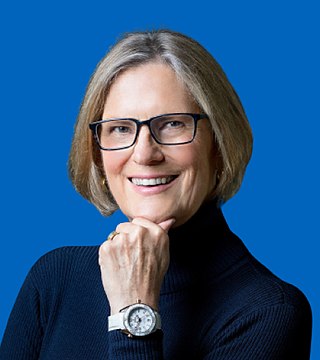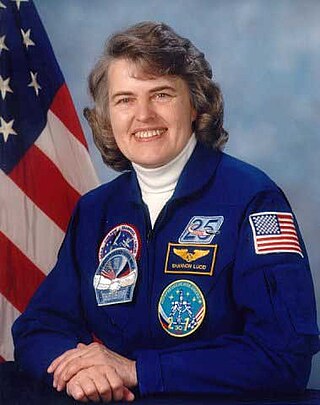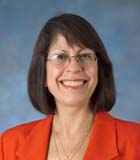
Sally Kristen Ride was an American astronaut and physicist. Born in Los Angeles, she joined NASA in 1978, and in 1983 became the first American woman and the third woman to fly in space, after cosmonauts Valentina Tereshkova in 1963 and Svetlana Savitskaya in 1982. She was the youngest American astronaut to have flown in space, having done so at the age of 32.

Eileen Marie Collins is a retired NASA astronaut and United States Air Force (USAF) colonel. A former flight instructor and test pilot, Collins was the first woman to pilot the Space Shuttle and the first to command a Space Shuttle mission.

Robert Laurel Crippen is an American retired naval officer and aviator, test pilot, aerospace engineer, and retired astronaut. He traveled into space four times: as pilot of STS-1 in April 1981, the first Space Shuttle mission; and as commander of STS-7 in June 1983, STS-41-C in April 1984, and STS-41-G in October 1984. He was also a part of the Manned Orbiting Laboratory (MOL), Skylab Medical Experiment Altitude Test (SMEAT), ASTP support crew member, and the Approach and Landing Tests (ALT) for the Space Shuttle.

Colin Michael Foale is a British-American astrophysicist and a former NASA astronaut. He is a veteran of six space missions, and is the only NASA astronaut to have flown extended missions aboard both Mir and the International Space Station. He was the second Briton in space and the first to perform a space walk. Until 17 April 2008, he held the record for most time spent in space by a US citizen: 374 days, 11 hours, 19 minutes, and as of 2024 he held the cumulative-time-in-space record for a British citizen.

Janet Lynn Kavandi, a native of Carthage, Missouri, is an American scientist and a NASA astronaut. She is a veteran of three Space Shuttle missions, served as NASA's Deputy Chief of the Astronaut Office, and was the Center Director at the NASA Glenn Research Center in Cleveland, Ohio from March 2016 until her retirement from NASA in September 2019. She was inducted into the United States Astronaut Hall of Fame in 2019.

Janice Elaine Voss was an American engineer and a NASA astronaut. Voss received her B.S. in engineering science from Purdue University, her M.S. in electrical engineering from MIT, and her PhD in aeronautics and astronautics from MIT. She flew in space five times, jointly holding the record for American women. Voss died in Arizona on February 6, 2012, from breast cancer.

Kathryn Dwyer Sullivan is an American geologist, oceanographer, and former NASA astronaut and US Navy officer. She was a crew member on three Space Shuttle missions.

Henry Warren Hartsfield Jr. was a United States Air Force Colonel and NASA astronaut who logged over 480 hours in space. He was inducted into the United States Astronaut Hall of Fame in 2006.

Michael Lloyd Coats is a former NASA astronaut, raised in Riverside, California. From December 2005 to December 2012, he served as Director of the Johnson Space Center in Houston, Texas.

Shannon Matilda Wells Lucid is an American biochemist and retired NASA astronaut. She has flown in space five times, including a prolonged mission aboard the Russian space station Mir in 1996, and is the only American woman to have stayed on Mir. From 1996 to 2007, Lucid held the record for the longest duration spent in space by an American and by a woman. She was awarded the Congressional Space Medal of Honor in December 1996, making her the tenth person and the first woman to be accorded the honor.

Richard Oswalt Covey is a retired United States Air Force officer, former NASA astronaut, and a member of the United States Astronaut Hall of Fame.

Nancy Jan Davis is a former American astronaut. A veteran of three space flights, Davis logged over 673 hours in space. She is now retired from NASA.

Margaret Rhea Seddon is an American surgeon and retired NASA astronaut. After being selected as part of the first group of astronauts to include women in 1978, she flew on three Space Shuttle flights: as a mission specialist on STS-51-D and STS-40, and as a payload commander for STS-58, accumulating over 722 hours in space. On these flights, she built repair tools for a US Navy satellite and performed medical experiments.

Ellen Louise Shulman Baker is an American physician and a former NASA astronaut. Baker is a veteran of three shuttle flights and logged more than 686 hours in space. Baker served as Chief of the Education/Medical Branch of the NASA Astronaut Office until her retirement in 2011 after more than 30 years of service to NASA.

Brian Duffy is a retired U.S. Air Force colonel and a former NASA astronaut. He flew aboard four Space Shuttle missions.

Bonnie Jeanne Dunbar is an American engineer and retired NASA astronaut. She flew on five Space Shuttle missions between 1985 and 1998, including two dockings with the Mir space station.

Carlos Ismael Noriega is a Peruvian-American NASA employee, a former NASA astronaut and a retired U.S. Marine Corps lieutenant colonel.

Nitza Margarita Cintrón is a Puerto Rican scientist and Chief of Space Medicine and Health Care Systems Office at NASA's Johnson Space Center.

Stephanie Diana Wilson is an American engineer and a NASA astronaut. She flew to space onboard three Space Shuttle missions, and is the second African American woman to go into space, after Mae Jemison. As of 2022, her 42 days in space are the second most of any female African American astronaut, having been surpassed by Jessica Watkins in 2022, however in 2024 she was assigned to the Crew-9 mission during which she should retake the lead.





















